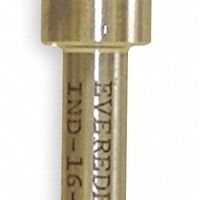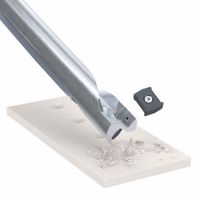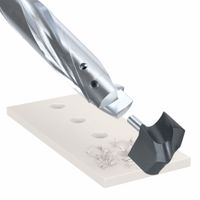Call +(254) 703 030 000 / 751 483 999 / 721 704 777
- Home
- Machining
- Indexable Cutting Tools
- Indexable Modular Drilling Holemaking
.....Read More
Frequently Asked Questions
What are the advantages of using indexable and modular drilling tools?
Indexable and modular drilling tools offer several advantages:
1. **Cost Efficiency**: These tools allow for the replacement of only the worn-out cutting edges or inserts, rather than the entire tool, reducing overall tooling costs.
2. **Versatility**: Modular systems enable quick changes between different tool heads or inserts, allowing for a wide range of applications and materials without the need for multiple complete tools.
3. **Reduced Downtime**: The ability to quickly replace inserts or tool heads minimizes machine downtime, enhancing productivity and operational efficiency.
4. **Improved Tool Life**: Indexable inserts are often made from advanced materials and coatings that extend tool life and maintain cutting performance over time.
5. **Precision and Consistency**: Modular systems ensure consistent tool geometry and cutting performance, leading to higher precision in machining operations.
6. **Inventory Management**: With modular tools, fewer complete tools are needed in inventory, simplifying stock management and reducing storage space requirements.
7. **Flexibility in Design**: Modular tools can be customized for specific applications, allowing for tailored solutions that meet unique machining requirements.
8. **Ease of Maintenance**: Simple replacement of inserts or tool heads makes maintenance straightforward, reducing the need for specialized skills or equipment.
9. **Environmental Benefits**: By reducing the need to discard entire tools, indexable and modular systems contribute to less waste and more sustainable manufacturing practices.
10. **Enhanced Performance**: The ability to use optimized inserts for specific materials or conditions can lead to improved cutting speeds, feeds, and overall machining performance.
How do indexable inserts differ from solid tools?
Indexable inserts and solid tools are both used in machining processes, but they differ in several key aspects:
1. **Design and Structure**:
- Indexable inserts are small, replaceable cutting tips that are clamped onto a tool holder. They can be rotated or flipped to use multiple cutting edges.
- Solid tools are single-piece tools where the cutting edge and the tool body are one unit, such as drills or end mills.
2. **Material Usage**:
- Indexable inserts are typically made from hard materials like carbide, ceramics, or cermets, allowing them to handle high-speed operations and tough materials.
- Solid tools can be made from high-speed steel, carbide, or other materials, depending on the application.
3. **Cost and Maintenance**:
- Indexable inserts are cost-effective in the long run as only the insert needs replacement, not the entire tool. This reduces downtime and inventory costs.
- Solid tools require regrinding or replacement once worn out, which can be more expensive and time-consuming.
4. **Flexibility and Versatility**:
- Indexable inserts offer flexibility as different inserts can be used with the same holder for various operations and materials.
- Solid tools are less versatile as each tool is designed for a specific operation or material.
5. **Performance and Precision**:
- Indexable inserts provide high precision and are suitable for high-speed machining, but may not achieve the same level of surface finish as solid tools.
- Solid tools can offer better surface finishes and are often used for precision work.
6. **Application**:
- Indexable inserts are commonly used in turning, milling, and drilling operations in industrial settings.
- Solid tools are often used in applications requiring high precision and fine finishes, such as in aerospace and medical industries.
What materials are best suited for indexable and modular drilling tools?
The best materials for indexable and modular drilling tools are typically those that offer a balance of hardness, toughness, and wear resistance. Common materials include:
1. **Carbide**: Cemented carbide is widely used for indexable inserts due to its excellent hardness and wear resistance. It is suitable for high-speed applications and can handle a variety of materials, including steel, cast iron, and non-ferrous metals.
2. **Cermet**: A composite material made of ceramic and metallic materials, cermet offers good wear resistance and a smoother finish than carbide. It is ideal for finishing operations and applications requiring high precision.
3. **High-Speed Steel (HSS)**: While not as hard as carbide, HSS is tougher and more resistant to chipping. It is often used in modular drilling tools where flexibility and toughness are required, especially in interrupted cuts or less rigid setups.
4. **Ceramics**: Ceramic inserts are used for high-speed machining of cast iron and hard steels. They offer excellent heat resistance and can maintain hardness at elevated temperatures, but they are more brittle than carbide.
5. **Polycrystalline Diamond (PCD)**: PCD is used for non-ferrous and abrasive materials like aluminum alloys and composites. It provides superior wear resistance and a long tool life but is not suitable for ferrous materials due to chemical reactions at high temperatures.
6. **Cubic Boron Nitride (CBN)**: CBN is ideal for hard turning and machining hardened steels. It offers excellent thermal stability and wear resistance, making it suitable for high-speed applications.
The choice of material depends on the specific application, workpiece material, and machining conditions. Each material offers unique advantages that can be leveraged to optimize tool performance and longevity.
How do you select the right indexable insert for a specific application?
Selecting the right indexable insert involves considering several key factors:
1. **Material Type**: Identify the workpiece material (e.g., steel, aluminum, cast iron) as it influences the insert's material and coating choice. Different materials require specific insert grades for optimal performance.
2. **Insert Geometry**: Choose the appropriate shape and size based on the operation (e.g., turning, milling, drilling). Common shapes include square, triangular, and round, each offering different strengths and cutting capabilities.
3. **Cutting Conditions**: Consider the cutting speed, feed rate, and depth of cut. Inserts are designed to perform under specific conditions, and selecting one that matches your parameters ensures efficiency and longevity.
4. **Coating**: Select a coating that enhances wear resistance and heat dissipation. Common coatings include TiN, TiCN, and Al2O3, each suited for different materials and cutting conditions.
5. **Insert Grade**: Choose the grade based on toughness and wear resistance required. Harder grades are suitable for high-speed operations, while tougher grades are better for interrupted cuts or roughing.
6. **Machine Tool Compatibility**: Ensure the insert is compatible with the machine tool and holder. Check for the correct clamping system and toolholder geometry.
7. **Surface Finish Requirements**: Determine the desired surface finish. Inserts with a sharper edge or specific chipbreaker design can improve surface quality.
8. **Cost and Availability**: Consider the cost-effectiveness and availability of the insert. Balance performance with budget constraints.
9. **Manufacturer Recommendations**: Consult manufacturer catalogs and technical support for guidance on the best insert for your application.
10. **Trial and Error**: Sometimes, testing different inserts in real-world conditions is necessary to find the optimal choice.
By evaluating these factors, you can select an indexable insert that maximizes productivity, tool life, and surface quality for your specific application.
What maintenance is required for indexable and modular drilling tools?
Maintenance for indexable and modular drilling tools involves several key practices to ensure optimal performance and longevity:
1. **Regular Inspection**: Frequently check the tool for wear, damage, or any signs of fatigue. Inspect the cutting edges, inserts, and tool body for chips, cracks, or deformation.
2. **Insert Replacement**: Replace worn or damaged inserts promptly. Ensure that the new inserts are compatible with the tool and are installed correctly to maintain balance and performance.
3. **Cleaning**: Clean the tool after each use to remove chips, debris, and coolant residues. Use appropriate cleaning agents and tools to avoid damaging the tool surfaces.
4. **Lubrication**: Apply suitable lubricants to moving parts and joints to reduce friction and wear. Ensure that the lubrication is compatible with the tool materials and the working environment.
5. **Calibration and Alignment**: Regularly check and adjust the tool's alignment and calibration to ensure precision in drilling operations. Misalignment can lead to poor hole quality and increased tool wear.
6. **Coolant System Maintenance**: Ensure the coolant system is functioning properly. Check for blockages, leaks, and ensure the coolant is clean and at the correct concentration to prevent overheating and tool damage.
7. **Storage**: Store tools in a clean, dry environment to prevent corrosion and damage. Use protective covers or cases to shield the tools from dust and physical impact.
8. **Documentation**: Keep detailed records of maintenance activities, tool usage, and performance. This helps in tracking tool life and planning for replacements or repairs.
9. **Training**: Ensure that operators are trained in the correct handling, usage, and maintenance procedures for the tools to prevent misuse and extend tool life.
10. **Tool Holder Maintenance**: Regularly inspect and maintain tool holders to ensure they are free from wear and damage, as they play a crucial role in tool stability and performance.
How do you properly index or change the inserts on these tools?
To properly index or change the inserts on cutting tools, follow these steps:
1. **Safety First**: Ensure the machine is turned off and locked out. Wear appropriate personal protective equipment (PPE) such as gloves and safety glasses.
2. **Identify the Insert Type**: Determine the type and size of the insert you are working with. This information is usually found in the tool's manual or on the insert itself.
3. **Gather Tools**: Use the correct tools for the job, typically a torque wrench or a specific key provided by the tool manufacturer.
4. **Remove the Insert**: Loosen the screw or clamp holding the insert in place. Carefully remove the insert, taking note of its orientation and position.
5. **Inspect the Pocket**: Check the insert pocket for any debris or damage. Clean it thoroughly to ensure a proper fit for the new insert.
6. **Indexing the Insert**: If the insert is indexable, rotate it to a fresh cutting edge. Ensure the new edge is properly aligned with the tool holder.
7. **Install the New Insert**: Place the new or indexed insert into the pocket, ensuring it sits flush and is correctly oriented.
8. **Secure the Insert**: Tighten the screw or clamp to the manufacturer's specified torque setting. Over-tightening can damage the insert or tool holder, while under-tightening can lead to insert movement during operation.
9. **Check Alignment**: Verify that the insert is properly aligned and seated. Misalignment can cause poor cutting performance and tool wear.
10. **Test the Setup**: Once the insert is secured, perform a test cut to ensure everything is functioning correctly.
11. **Document the Change**: Record the insert change in maintenance logs for future reference and tool life tracking.
Following these steps ensures the tool operates efficiently and safely, maintaining optimal performance and extending tool life.
What are the common challenges faced when using indexable and modular drilling tools?
Common challenges when using indexable and modular drilling tools include:
1. **Tool Wear and Life**: Indexable inserts can wear out quickly, especially in hard materials, leading to frequent replacements and increased downtime.
2. **Vibration and Stability**: Modular tools can suffer from vibration and lack of stability, affecting precision and surface finish. This is particularly problematic in deep-hole drilling.
3. **Alignment and Setup**: Ensuring proper alignment and setup of modular components can be time-consuming and requires skilled operators to avoid misalignment, which can lead to tool breakage or poor hole quality.
4. **Chip Evacuation**: Efficient chip removal is crucial. Poor chip evacuation can cause tool clogging, increased heat, and tool failure, especially in deep or blind holes.
5. **Cost**: While modular tools offer flexibility, the initial investment and cost of replacement parts can be high. Balancing cost with performance is a challenge.
6. **Material Compatibility**: Not all indexable inserts are suitable for all materials. Selecting the right insert for the material being drilled is critical to avoid poor performance and tool damage.
7. **Coolant and Lubrication**: Proper coolant application is essential to reduce heat and extend tool life. Inadequate lubrication can lead to overheating and tool wear.
8. **Complexity in Tool Selection**: The wide variety of available inserts and modular components can make selecting the right tool complex, requiring in-depth knowledge and experience.
9. **Tool Rigidity**: Modular tools may lack the rigidity of solid tools, affecting accuracy and leading to deflection, especially in high-speed applications.
10. **Maintenance and Inventory Management**: Keeping track of various components and ensuring they are in good condition adds to the maintenance burden and requires effective inventory management.



